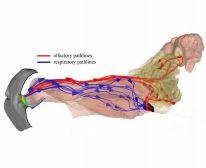DR DOLPHIN
SPRING 2021
Key Concepts Why do we have Different Blood Types? If you’re in an accident and a panicked bystander asks you your type, here’s why you don’t respond with tall, dark-haired and charismatic. Much like your potential significant other, there’s a few options to choose from: A, B, AB and O. Why does this occur? Red blood cells, like all cells (except white blood cells), have small globular proteins on their surface called antigens. These antigens act as markers to white blood cells, which have antibodies on their surface, to tell them that they are not pathogenic so that your white blood cells don’t attack them. This works because each antigen has its own complementary antibody. If a pathogen does enter the body, a white blood cell with the matching antigen binding site will come along and recognise it as a foreign threat and alert the white blood cells to destroy it. People have different antigens depending on their genetic makeup and these types can be categorized into the blood types mentioned above. An Austrian doctor, Karl Landsteiner, identified the most common blood antigens in 1901, which he called A and B. He also found that some people had neither antigen (type O), and in 1902 two of his students discovered that some people have both antigens (type AB). Blood can also be classified using the Rhesus system, or Rh for short. Funnily enough, it was named after the rhesus monkey in which it was first discovered. In this system, if a person has RhD antigens on the surface of their red blood cells, they
are Rh positive, if they don’t, they’re Rh negative. In Australia, around 83% of people are Rh positive. The two systems are usually combined in order to achieve maximum precision, giving us 8 possible blood types. As a result, it is vital that blood transfusions occur between people of the same blood type. If not, the recipient’s antibodies will detect an impostor in the new blood’s different antigens and alert the white blood cells to attack in a process called haemolysis (when the red blood cells are destroyed). As the body wages an internal civil war, the patient may experience a dangerously high fever, blood in the urine, and kidney failure. Not fun. Luckily, nowadays, blood is meticulously screened before being administered to patients to avoid rejection; not only does it put the patient at risk, it’s a waste of a precious donation. One difference between the Rhesus system and the ABO group system is that Rh negative people don’t usually possess antibodies against RhD (unless they have been previously exposed to it), whereas in the ABO group system if the antigen is absent from the red blood cell, the antibody against it is present in the plasma. Testing to see if you’re Rh positive or negative is routinely done during pregnancy, blood donation and before a blood transfusion. If a mother is Rh negative but her baby is Rh positive (which can happen if the father is Rh positive), the mother could produce antibodies that fight the baby’s red blood cells. This can happen if blood from the unborn baby enters the mother’s circulation. When there is a risk of this happening an injection called anti-D can be given to the
32



